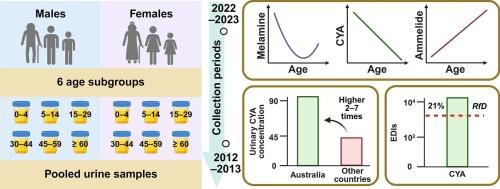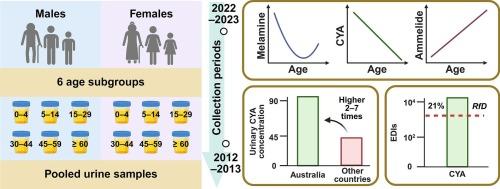Melamine and its derivatives in Australian pooled urine samples from 2012–2013 and 2022–2023
IF 9.7
1区 环境科学与生态学
Q1 ENVIRONMENTAL SCIENCES
引用次数: 0
Abstract
Melamine is a versatile compound with various industrial and commercial applications, and the long-term use has resulted in its widespread occurrence in the environment. Furthermore, illicit addition of melamine into food products has raised interest in this compound. The aim of this study was to provide the first assessment of exposure to melamine and its derivatives in the Australian population. De-identified urine specimens collected in 2012–2013 and 2022–2023 were obtained from a community-based pathology laboratory and were pooled based on sex and age groups (n = 48 pools of 100, to a total of 4800 individual samples). Melamine, cyanuric acid (CYA), and ammelide were frequently detected in the pooled urine samples, with mean concentrations of 4.3, 94, and 4.2 ng/mL, respectively. A U-shaped trend in urinary concentrations of melamine was identified as age increased. Children and adolescents (< 15 years old) represented key groups for high exposure to CYA, whereas older individuals (≥45 years old) had higher exposure risk to ammelide. No temporal or sex differences was observed in urinary concentrations of melamine and its derivatives. Compared to other countries, high concentrations of CYA were observed in samples collected from the Australian population. From the estimated CYA daily intakes, 21 % of urine pools exceeded reference doses (2.5 μg/kg bw/day). To the best of our knowledge, this is the first study to reveal continued exposure of melamine and its derivatives in the Australian population and underscore the age trends of their urinary concentrations.


澳大利亚收集了2012-2013年和2022-2023年的尿液样本,其中包括三聚氰胺及其衍生物
三聚氰胺是一种用途广泛的化合物,具有多种工业和商业用途,长期使用已导致其在环境中广泛存在。此外,在食品中非法添加三聚氰胺引起了人们对这种化合物的兴趣。这项研究的目的是对澳大利亚人口接触三聚氰胺及其衍生物的情况进行首次评估。2012-2013年和2022-2023年从社区病理学实验室收集的去鉴定尿液标本,并根据性别和年龄组进行汇总(n = 48组100例,共4800例个体样本)。三聚氰胺、氰尿酸(CYA)和氨酰胺在汇集的尿液样本中检出频率较高,平均浓度分别为4.3、94和4.2 ng/mL。随着年龄的增长,尿中三聚氰胺的浓度呈u型趋势。儿童和青少年(<; 15 岁)是CYA高暴露的关键群体,而老年人(≥45 岁)对氨酰亚胺的暴露风险更高。尿中三聚氰胺及其衍生物的浓度没有时间或性别差异。与其他国家相比,从澳大利亚人群中收集的样本中观察到高浓度的CYA。从估计的CYA每日摄入量来看,21% %的尿池超过了参考剂量(2.5 μg/kg bw/day)。据我们所知,这是第一个揭示澳大利亚人群持续接触三聚氰胺及其衍生物的研究,并强调了其尿液浓度的年龄趋势。
本文章由计算机程序翻译,如有差异,请以英文原文为准。
求助全文
约1分钟内获得全文
求助全文
来源期刊

Environment International
环境科学-环境科学
CiteScore
21.90
自引率
3.40%
发文量
734
审稿时长
2.8 months
期刊介绍:
Environmental Health publishes manuscripts focusing on critical aspects of environmental and occupational medicine, including studies in toxicology and epidemiology, to illuminate the human health implications of exposure to environmental hazards. The journal adopts an open-access model and practices open peer review.
It caters to scientists and practitioners across all environmental science domains, directly or indirectly impacting human health and well-being. With a commitment to enhancing the prevention of environmentally-related health risks, Environmental Health serves as a public health journal for the community and scientists engaged in matters of public health significance concerning the environment.
 求助内容:
求助内容: 应助结果提醒方式:
应助结果提醒方式:


